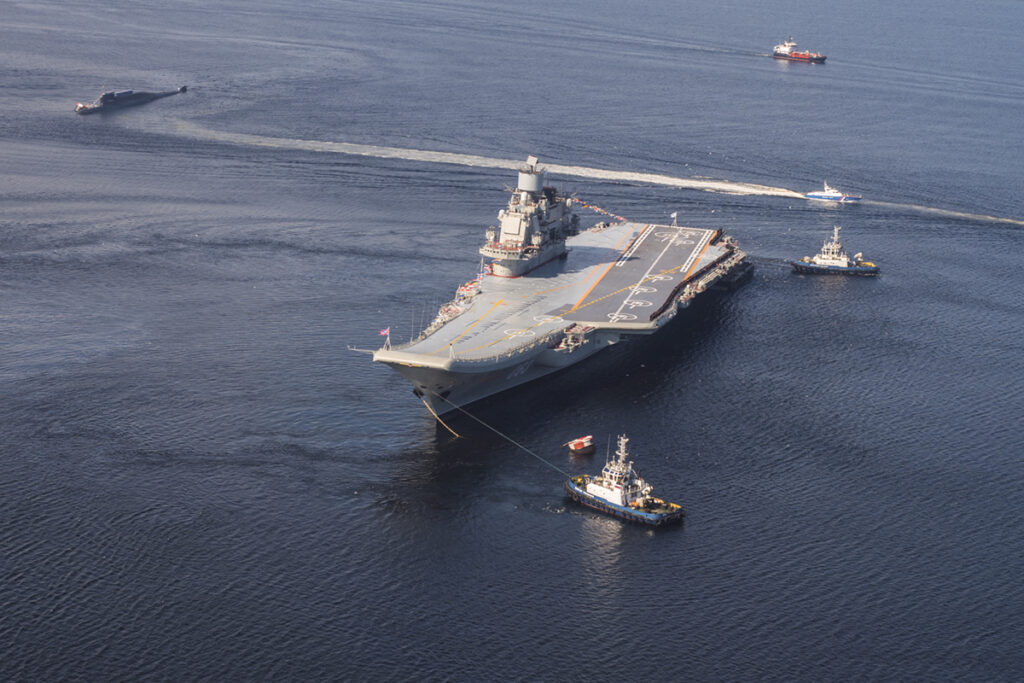The Admiral Kuznetsov, Russia’s sole aircraft carrier, is less a symbol of naval might than a floating monument to dysfunction. Born in the waning days of the Soviet Union, this massive vessel has spent much of its life tethered to a dock, plagued by breakdowns, accidents, and a chronic lack of infrastructure. Its story begins with a brazen act—stolen from a newly independent Ukraine in 1991—and spirals into a saga of mismanagement that would make even the saltiest sailor wince. Frankly, it’s a marvel the ship still floats at all.
Conceived as the Soviet Union’s grand foray into carrier-based naval power, the Kuznetsov’s journey started with ambition. Laid down in 1982 as “Riga,” it was renamed multiple times—first to honor Leonid Brezhnev, then as “Tbilisi,” before finally settling on “Admiral Kuznetsov” in 1990. Each name change, superstitious sailors might argue, courted bad luck. By the time it was commissioned in 1991, the Soviet Navy was woefully unprepared. No air groups, no task forces, no air traffic control teams, and—most critically—no proper port facilities. The ship’s first commander, Viktor Yarygin, admitted as much to a Soviet newspaper, lamenting the navy’s unreadiness for such a beast. What’s striking is how this lack of foresight set the tone for decades of neglect.
The Kuznetsov’s troubles were compounded by geopolitics. When Ukraine declared independence in 1991, its president claimed the carrier as Ukrainian property, ordering it to remain docked. But Yarygin, loyal to Moscow, saw Ukraine’s independence as illegitimate. On the very day Ukrainians voted overwhelmingly for sovereignty, he sailed the unfinished ship to Murmansk, a Russian port ill-equipped to handle it. A third of the crew stayed behind, leaving the Kuznetsov shorthanded and incomplete. It was a heist of sorts, executed under the nose of a fledgling nation, but it delivered the carrier to a navy that couldn’t support it.
What’s troubling is how the Kuznetsov became a facade—a Potemkin village on water, projecting an illusion of Russian strength. Its first deployment in 1995 to the Mediterranean was more about flexing than fighting. With no real combat role, the carrier was a status symbol, meant to signal Russia’s place among the world’s naval powers. Yet, behind the scenes, it was a mess. Crews rationed water to 20 minutes a day due to broken evaporators. The ship’s eight pressurized boilers, notoriously unreliable, failed repeatedly, leaving the Kuznetsov dead in the water. During its 2016 deployment to Syria—its only combat mission—it had to be towed back to port by the tugboat Nikolay Chiker after yet another propulsion failure. You get the picture: this was no fearsome war machine.
The carrier’s woes go beyond mechanical failures. In Syria, two aircraft crashed due to faulty arresting gear. An Su-33 snapped a cable and plunged off the deck; days later, a MiG-29K ran out of fuel circling the ship, waiting for repairs that never came. Both pilots ejected safely, but the incidents underscored a grim reality: the Kuznetsov was as dangerous to its own crew as to any enemy. Then, in 2018, disaster struck again. While in drydock for a midlife refit, the floating dock PD-50 lost power and sank, dropping a 70-ton crane onto the carrier’s flight deck, leaving a gaping hole. The dock’s emergency generators? Useless, with no diesel fuel ever purchased. To top it off, the shipyard’s director was later arrested for embezzling $650,000 meant for repairs.
The root of these failures lies in a simple truth: the Soviet Union, and later Russia, prioritized building ships over maintaining them. Unlike U.S. Nimitz-class carriers, which rely on shore-based power and water when docked, the Kuznetsov’s boilers ran constantly, even at port, to supply the crew. This premature wear has left four of its eight boilers in need of replacement, despite the ship spending just 450 days at sea over three decades—barely 15 days a year. Compare that to American carriers, which log thousands of days underway, and the contrast is stark.
There’s a certain irony here. Russia’s obsession with projecting power has left it with a carrier that’s more liability than asset. The Kuznetsov’s six short deployments, mostly to the Mediterranean, were less about military might than maintaining appearances. Even its aircraft numbers were fudged in Soviet times, with sailors repainting plane numbers to fool American intelligence into overestimating the fleet. Today, Russia struggles to train enough pilots for the planes it does have, rendering the carrier’s air wing more theoretical than operational.
As the Kuznetsov limps toward the end of its refit, Russia is finally building a proper drydock in Murmansk—a belated admission of past failures. But the question lingers: can a ship so steeped in misfortune ever fulfill its role? The Kuznetsov isn’t just a relic of Soviet ambition; it’s a cautionary tale of what happens when grandeur outpaces practicality. I can’t help but feel a twinge of pity for the crews who’ve served on her, enduring breakdowns and indignities in the name of national pride. Russia may insist on keeping its lone carrier afloat, but without serious investment—and a break from its cursed luck—the Kuznetsov risks remaining a naval embarrassment, towed along by its ever-present tugboat.



